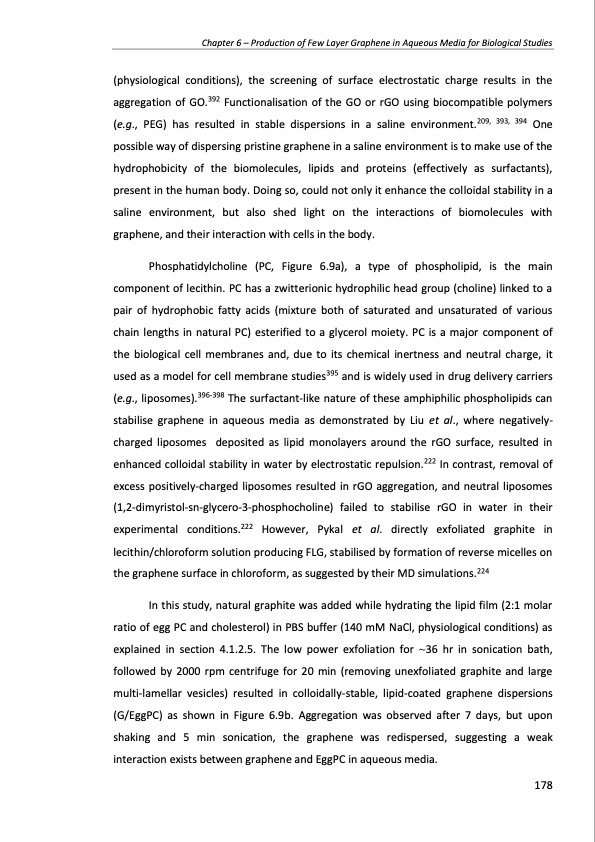PDF Publication Title:
Text from PDF Page: 178
Chapter 6 – Production of Few Layer Graphene in Aqueous Media for Biological Studies (physiological conditions), the screening of surface electrostatic charge results in the aggregation of GO.392 Functionalisation of the GO or rGO using biocompatible polymers (e.g., PEG) has resulted in stable dispersions in a saline environment.209, 393, 394 One possible way of dispersing pristine graphene in a saline environment is to make use of the hydrophobicity of the biomolecules, lipids and proteins (effectively as surfactants), present in the human body. Doing so, could not only it enhance the colloidal stability in a saline environment, but also shed light on the interactions of biomolecules with graphene, and their interaction with cells in the body. Phosphatidylcholine (PC, Figure 6.9a), a type of phospholipid, is the main component of lecithin. PC has a zwitterionic hydrophilic head group (choline) linked to a pair of hydrophobic fatty acids (mixture both of saturated and unsaturated of various chain lengths in natural PC) esterified to a glycerol moiety. PC is a major component of the biological cell membranes and, due to its chemical inertness and neutral charge, it used as a model for cell membrane studies395 and is widely used in drug delivery carriers (e.g., liposomes).396-398 The surfactant-like nature of these amphiphilic phospholipids can stabilise graphene in aqueous media as demonstrated by Liu et al., where negatively- charged liposomes deposited as lipid monolayers around the rGO surface, resulted in enhanced colloidal stability in water by electrostatic repulsion.222 In contrast, removal of excess positively-charged liposomes resulted in rGO aggregation, and neutral liposomes (1,2-dimyristol-sn-glycero-3-phosphocholine) failed to stabilise rGO in water in their experimental conditions.222 However, Pykal et al. directly exfoliated graphite in lecithin/chloroform solution producing FLG, stabilised by formation of reverse micelles on the graphene surface in chloroform, as suggested by their MD simulations.224 In this study, natural graphite was added while hydrating the lipid film (2:1 molar ratio of egg PC and cholesterol) in PBS buffer (140 mM NaCl, physiological conditions) as explained in section 4.1.2.5. The low power exfoliation for ~36 hr in sonication bath, followed by 2000 rpm centrifuge for 20 min (removing unexfoliated graphite and large multi-lamellar vesicles) resulted in colloidally-stable, lipid-coated graphene dispersions (G/EggPC) as shown in Figure 6.9b. Aggregation was observed after 7 days, but upon shaking and 5 min sonication, the graphene was redispersed, suggesting a weak interaction exists between graphene and EggPC in aqueous media. 178PDF Image | PRODUCTION AND APPLICATIONS OF GRAPHENE AND ITS COMPOSITES

PDF Search Title:
PRODUCTION AND APPLICATIONS OF GRAPHENE AND ITS COMPOSITESOriginal File Name Searched:
graphene-production-applications.PDFDIY PDF Search: Google It | Yahoo | Bing
Salgenx Redox Flow Battery Technology: Power up your energy storage game with Salgenx Salt Water Battery. With its advanced technology, the flow battery provides reliable, scalable, and sustainable energy storage for utility-scale projects. Upgrade to a Salgenx flow battery today and take control of your energy future.
CONTACT TEL: 608-238-6001 Email: greg@infinityturbine.com (Standard Web Page)